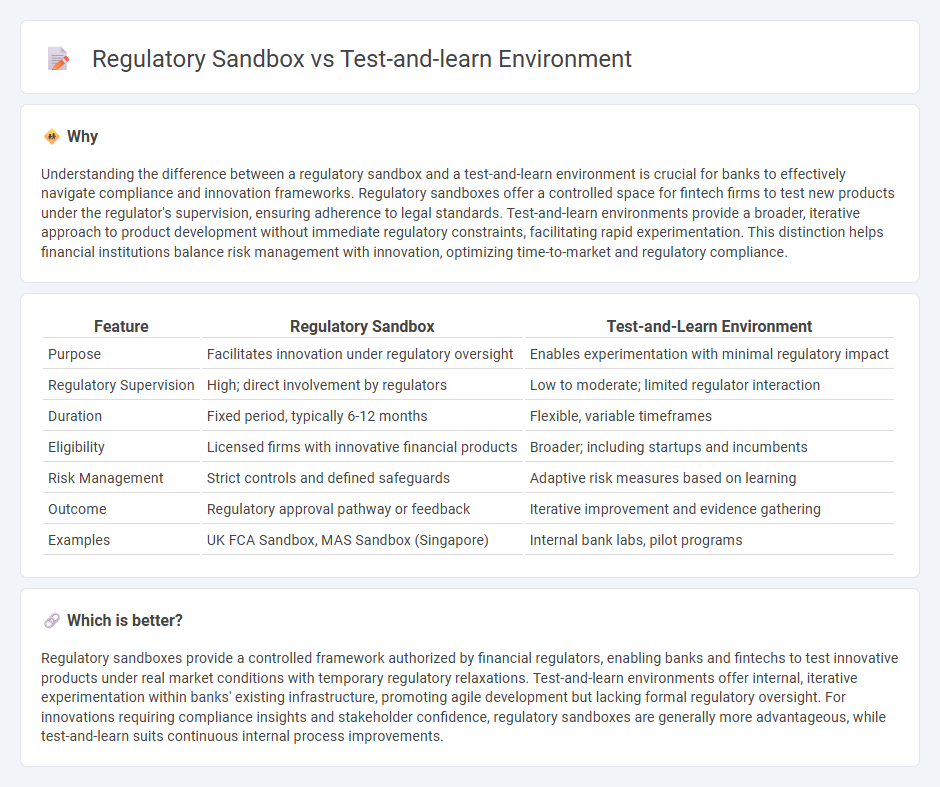
Regulatory sandbox and test-and-learn environments serve distinct roles in banking innovation, offering controlled settings for fintech experimentation with real-world data and regulatory oversight. While regulatory sandboxes focus on compliance with financial regulations under the supervision of authorities like the FCA or SEC, test-and-learn environments emphasize iterative product development and customer feedback within less stringent frameworks. Explore how these frameworks enhance banking innovation and risk management by learning more about their unique features and applications.
Why it is important
Understanding the difference between a regulatory sandbox and a test-and-learn environment is crucial for banks to effectively navigate compliance and innovation frameworks. Regulatory sandboxes offer a controlled space for fintech firms to test new products under the regulator's supervision, ensuring adherence to legal standards. Test-and-learn environments provide a broader, iterative approach to product development without immediate regulatory constraints, facilitating rapid experimentation. This distinction helps financial institutions balance risk management with innovation, optimizing time-to-market and regulatory compliance.
Comparison Table
| Feature | Regulatory Sandbox | Test-and-Learn Environment |
|---|---|---|
| Purpose | Facilitates innovation under regulatory oversight | Enables experimentation with minimal regulatory impact |
| Regulatory Supervision | High; direct involvement by regulators | Low to moderate; limited regulator interaction |
| Duration | Fixed period, typically 6-12 months | Flexible, variable timeframes |
| Eligibility | Licensed firms with innovative financial products | Broader; including startups and incumbents |
| Risk Management | Strict controls and defined safeguards | Adaptive risk measures based on learning |
| Outcome | Regulatory approval pathway or feedback | Iterative improvement and evidence gathering |
| Examples | UK FCA Sandbox, MAS Sandbox (Singapore) | Internal bank labs, pilot programs |
Which is better?
Regulatory sandboxes provide a controlled framework authorized by financial regulators, enabling banks and fintechs to test innovative products under real market conditions with temporary regulatory relaxations. Test-and-learn environments offer internal, iterative experimentation within banks' existing infrastructure, promoting agile development but lacking formal regulatory oversight. For innovations requiring compliance insights and stakeholder confidence, regulatory sandboxes are generally more advantageous, while test-and-learn suits continuous internal process improvements.
Connection
Regulatory sandbox and test-and-learn environments both enable financial institutions to innovate by testing new banking products, services, and business models under regulatory supervision before full-scale deployment. These frameworks facilitate controlled experimentation, allowing banks to assess risks, comply with regulations, and gather user feedback while minimizing potential adverse impacts on customers and the financial system. The connectivity between sandbox and test-and-learn approaches accelerates digital transformation in banking by fostering safe innovation and regulatory collaboration.
Key Terms
Experimentation
Test-and-learn environments emphasize iterative experimentation by enabling businesses to trial innovative products and services in controlled, real-world settings with flexible parameters to adjust strategies based on outcomes. Regulatory sandboxes provide a structured framework where companies can test new technologies under regulatory supervision, ensuring compliance while gathering data to inform safer market entry. Explore more about how these frameworks foster innovation and risk management in highly regulated industries.
Compliance
Test-and-learn environments enable businesses to experiment with innovative products under less stringent oversight, accelerating market entry while maintaining core compliance standards. Regulatory sandboxes offer a more structured framework with close supervision by authorities, ensuring that all activities strictly adhere to legal and regulatory requirements throughout the trial phase. Explore the nuances between these approaches to optimize compliance strategies effectively.
Risk management
A test-and-learn environment allows organizations to experiment with new products or services in a controlled setting to identify and mitigate risks before full-scale launch. Regulatory sandboxes provide a framework supervised by regulators, enabling firms to test innovations while ensuring compliance and safeguarding consumer interests. Explore detailed comparisons to enhance your understanding of risk management in these innovative frameworks.
Source and External Links
Building a Test & Learn Process: The path to being data-driven - A test-and-learn environment uses a clear, structured process and includes stakeholders early to enable teams to experiment methodically, learn effectively, and align improvements with strategic goals in an organization.
What is test and learn? - MarketDial - Test-and-learn is a business approach involving experimentation, analysis, and data-driven decision making, often supported by software tools like A/B testing and multivariate testing platforms to optimize strategies and outcomes.
Test and Learn Culture: The Key to Data-Driven Optimization and ... - A test-and-learn environment is a culture where all business changes are treated as hypotheses to test, emphasizing continuous experimentation and learning to prioritize strategies with proven results and foster innovation.
 dowidth.com
dowidth.com